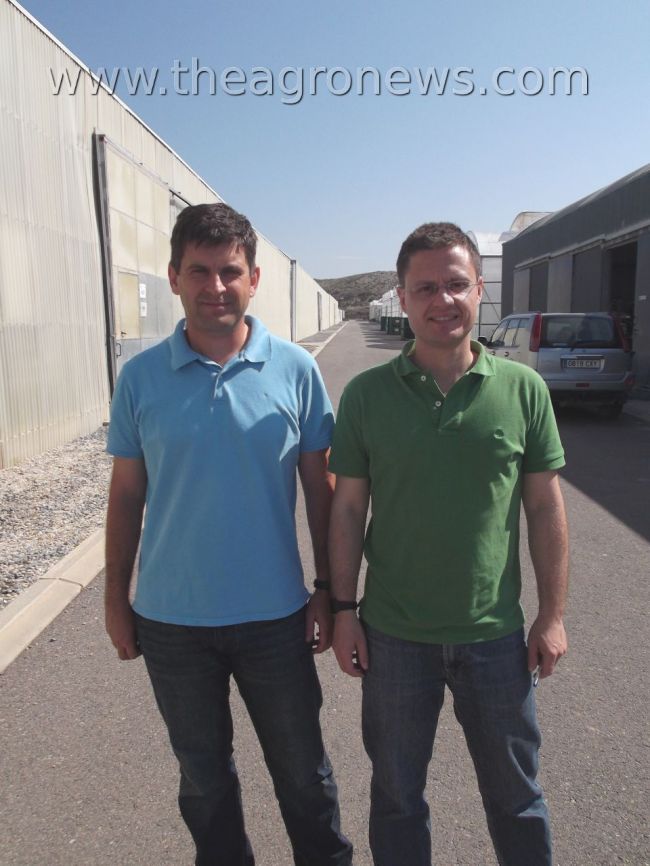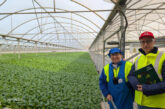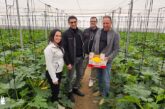De todos los centros de investigación hortofrutícola repartidos por la provincia almeriense, y hay unos cuantos, el de la Fundación Universidad de Almería-Anecoop es el que menos aparece en prensa; sin embargo, esta finca es una auténtica fábrica de investigadores, ya que en ella trabajan a diario los principales grupos de investigación de esta Universidad; amén de numerosas multinacionales que ensayan nuevos productos y procesos en este enclave investigador.
Fernando Toresano, profesor de la UAL y responsable de investigación de esta finca, me muestra algunos de los actuales proyectos que en ella se desarrollan (Fernando aparece en la fotografía adjunta a la derecha, acompañado por Javier Núñez, de Anecoop, responsable de experimentación). En uno de los invernaderos de sandía hay paneles fotovoltaicos instalados en la cubierta. Se estudia el efecto del sombreo sobre el cultivo, nuevos nutrientes y en otras naves también se ensaya con los superpolinizadores de las distintas casas comerciales.
Otros grupos investigan en la finca diversas mallas anti-insectos que eviten la entrada de trips, pero que no empeoren la ventilación del invernadero. También se comparan sistemas de calefacción antiguos con otros más modernos, como las biocalderas que funcionan con biocombustibles sólidos. Por otro lado, hay una nave de un proyecto de colaboración, recién terminado, entre la Universidad Agraria de La Habana (Cuba) y la Universidad de Almería. En ella se probaban alternativas al bromuro de metilo.
Más cosas, otros investigadores como Marisa Gallardo y Rodney Thompson analizan los niveles de nitrógeno en el subsuelo; el mejicano César Ruiz está en varios proyectos, alguno de agricultura ecológica, y en otros analiza los nuevos patógenos del suelo que atacan al cuello y la raíz de la planta de tomate. La lista de trabajos y ensayos es mucho más amplía, pero la continuaremos más adelante, ya en Agronews, www.agronews.es
UAL-Anecoop farm, a researchers’ factory
Of all the horticultural research centers located throughout the province of Almeria, and there are quite a few, the center of the University Almeria-Anecoop Foundation is the one that appears the least in newspapers. However, this farm is really a researchers’ factory, since the leading research groups of this University work daily in it, in addition to numerous multinational that test new products and processes in this place for research.
Fernando Toresano, professor in the UAL (University of Almeria) and head of research of this farm, shows me some of the current projects developed in it (Fernando’s picture is attached to the right, accompanied by Javier Nunez, Anecoop responsible for experimentation). In one of the watermelon greenhouses there are photovoltaic panels installed on the cover. They study the effect of shading on the cultivation, new nutrients and in other plants they also test with super-pollinators of the different commercial companies.
Other groups research in the farm various anti-insect nets that avoid the entry of thrips, but that do not worsen the air circulation of the greenhouse. They also compare older heating systems with more modern ones, such as bioboilers that run with solid biofuels. On the other hand, there is a plant of a collaboration project, recently completed, between the Agrarian University of La Havana (Cuba) and the University of Almeria. In it they were proving alternatives to methyl bromide.
More things, other researchers such as Marisa Gallardo and Rodney Thompson analyze the levels of nitrogen in the subsoil; the Mexican Cesar Ruiz is working on several projects, some of organic agriculture, and in others he analyzes the new soil pathogens that attack the neck and root of the tomato plant. The list of jobs and tests is much more larger, but we will continue with that later on in Agronews, www.agronews.es











